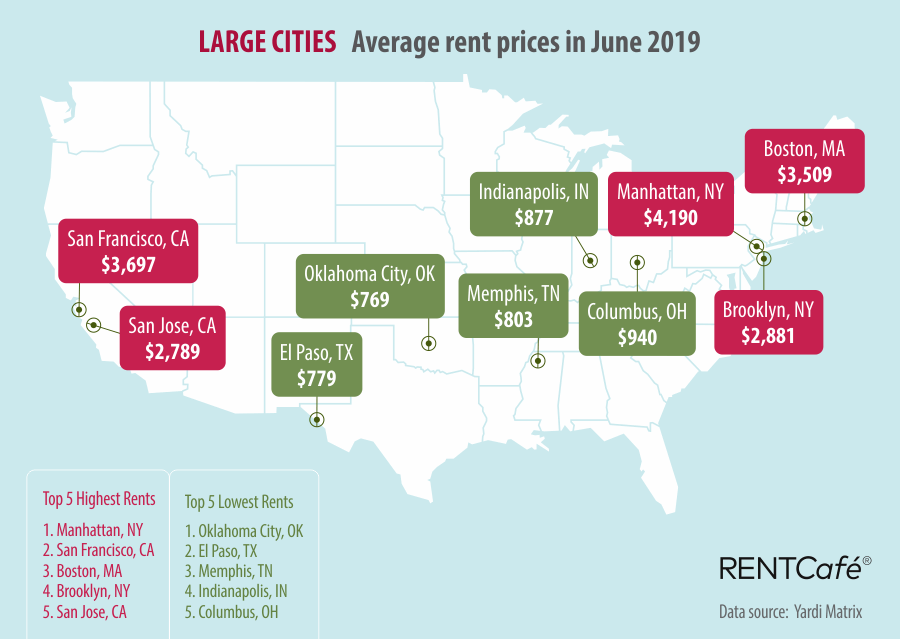This story is featured in Property Portfolio, Inman’s new free weekly newsletter. Every Tuesday, we’ll explore the overlapping worlds of real estate professionals and the fast-growing property investment and management sector. Sign up to receive Property Portfolio here.
Rents in the U.S. have steadily risen over the last year, including last month when there was an unusually large jump, according to a new report from RentCafé.
The report shows that the average U.S. rent in June was $1,465, up 3.2 percent year-over-year. That means American renters were paying an average of $45 more for rent last month than they were a year ago. Additionally, in just the first six months of 2019, rents increased by 2.9 percent, or $37.
These numbers follow a string of other recent reports that also showed consistently rising rents in some housing subcategories, such as single-family homes or specific geographic regions.
This latest report, however, adds that in June alone average U.S. rents rose 0.8 percent, or $12, compared to one month prior. RentCafé — which provides apartment search and leasing services in addition to market analysis — notes that this rise is “the highest monthly jump since May 2018.”

var divElement = document.getElementById(‘viz1563399232403’); var vizElement = divElement.getElementsByTagName(‘object’)[0]; if ( divElement.offsetWidth > 500 ) { vizElement.style.width=’500px’;vizElement.style.height=’654px’;} else if ( divElement.offsetWidth > 300 ) { vizElement.style.width=’500px’;vizElement.style.height=’654px’;} else { vizElement.style.width=’100?%’;vizElement.style.height=’537px’;} var scriptElement = document.createElement(‘script’); scriptElement.src = ‘https://public.tableau.com/javascripts/api/viz_v1.js’; vizElement.parentNode.insertBefore(scriptElement, vizElement);
 What to look for in a results-driven real estate team
For senior real estate advisors Richard Silver and Jim Burtnick, partnering brings a breadth of knowledge and a balance of skills READ MORE
What to look for in a results-driven real estate team
For senior real estate advisors Richard Silver and Jim Burtnick, partnering brings a breadth of knowledge and a balance of skills READ MORE
Of course, not every metro area has seen rents rise at equal rates. The RentCafé report notes, for example, that New York City had the highest average rent in June at $4,190. However, that number actually represents a decrease of 0.1 percent over the first six months of 2019.
Phoenix, on the other hand, saw rents jump 5.8 percent during the first half of 2019, making it the metro area with the most significant increase. However, the Arizona city’s average rent was still only $1,084 — far below any of the most expensive markets.
Chicago saw the second highest jump in rent so far this year, with a 4.8 percent increase, followed by Las Vegas at 4.7 percent, Charlotte, North Carolina, at 4.1 percent and Austin, Texas, at 3.9 percent.
RentCafé additionally found that Indianapolis is the “most budget-friendly large renter hub in the country with $877 on average per month despite a 2.8 percent increase since the beginning of the year.” Other top affordable large cities include Columbus, Ohio, Oklahoma City, and El Paso, Texas.

Credit: RentCafé
High rents also appear to be trickling down from the priciest metro areas into surrounding communities. RentCafé notes, for example, that Oakland, California has been “feeling the San Francisco effect for some time now” and in June had an average rent of $2,800 — a figure the report describes as “the highest among mid-size markets.”
San Mateo, California — another Bay Area and Silicon Valley-adjacent community — also saw a jump of $131 in average rents during the beginning of the year, “making it the small city with the highest average rent among the ones analyzed.”
Consistently rising rents have become a regular news item in recent months, prompting an array of proposed solutions ranging from more construction to tighter regulation. In California, which includes several of the most expensive cities in the U.S., lawmakers, and housing advocates have spent the spring and summer debating how exactly to alter, and potentially strengthen, rent control laws.
While the long-term outcome of those various efforts remains to be seen, RentCafé’s report offers at least some short-term hope for renters looking for relief.
“Rent increases during the first half of the year are typically more accelerated,” the report notes, “whereas during the second half of the year they’re expected to slow down, a typical pattern confirmed by rent evolution in the past years.”
Source: click here














